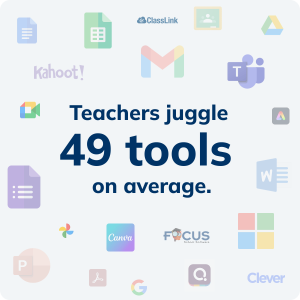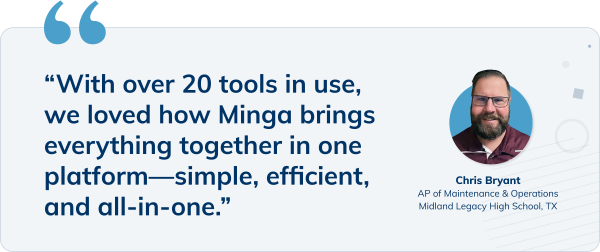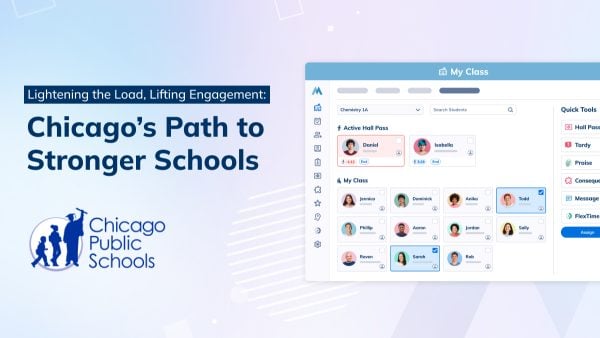Managing IT for a school district is often compared to running a small business — except the “customers” aren’t just a few hundred employees, but thousands of teachers, students, and families who rely on seamless technology every single day. You could probably make the argument that running a small business is easier.
And on top of this responsibility is a growing challenge – tool sprawl. It’s estimated that the average school district in the US will use nearly 3,000 distinct edtech tools in 2025 – which is an increase of around 9% from the year before.
It’s become a support and compliance headache that grows bigger every year.
The Challenge of Tech Sprawl
For the people on the ground, the overload is real. Teachers juggle around 49 tools on average each year. Students aren’t far behind, managing an average of 45. The result? Tech fatigue, fractured experiences, and less time spent on what matters most — teaching and learning.
But the burden doesn’t stop there. Every new tool creates scope creep — another vendor to manage, another integration to troubleshoot, another support ticket waiting to happen. IT teams are left with ballooning vendor lists, endless procurement cycles, and a growing administrative headache.
And with so many platforms in play, risks inevitably rise. More vendors mean more accounts to manage, more data scattered across systems, and more opportunities for something to slip through the cracks.
In short: tool sprawl isn’t just inconvenient. It’s unsustainable.
Where Minga Fits In
Simplification should be considered a strategy. Consolidation isn’t about cutting for the sake of cutting — it’s about taking back control of an increasingly complex ecosystem. Done right, it doesn’t reduce functionality; it enhances it.
How?
- Fewer vendors to vet means fewer contracts to manage.
- Streamlined logins = reduced credential risk.
- Less duplication of tools and costs.
- Stronger compliance oversight with fewer gaps.
- Simplified incident response and tighter data protection.
Consolidation isn’t just about saving dollars. It’s about building smarter processes, reducing daily workload for teachers and students, and giving IT leaders the visibility and control they need to protect their districts.
Why Consolidation Matters
At Minga, we see ourselves as a true consolidation partner. Instead of managing a patchwork of point solutions, schools and districts can streamline critical functions into a single, unified platform.
- Replace multiple tools: Minga combines digital hall passes, tardy management, flex periods, student engagement tools, events and communication, all in one place.
- District-wide scalability: tailored to individual schools, but centrally managed by IT for consistency and control.
- Reduced IT burden: with an intuitive, user-friendly design, support tickets go down and training overhead is minimized.
- Budget advantage: cutting redundant tools frees up dollars for higher-impact initiatives.
- Security advantage: fewer integrations mean a smaller attack surface and simpler compliance oversight.

Just as important, Minga is a platform your staff and schools will actually love using. And that matters for IT in two big ways:
- Better adoption = less resistance, less shadow IT, and stronger engagement.
- When people embrace the tool, IT isn’t stuck replacing it in a year. That’s less risk, less churn, and more long-term value.
Proof Points: Real World Adoption
The story of Midland Legacy High School is a clear example of what consolidation looks like in action. With over 2,700 students and a busy open-campus environment, staff struggled to manage hall passes, tardies, and large-scale events using a patchwork of spreadsheets and disconnected systems.
By adopting Minga, Midland Legacy was able to:
- Reduce tardies significantly: automated tracking and accountability shifted culture, with students hurrying to class instead of lingering in hallways.
- Simplify event management and improve security: digital IDs and check-ins kept football games with 12,000+ attendees organized and safe.
- Unify tools into one platform: eliminating redundant systems and creating efficiency through integration with existing SIS platforms.
- Spark district-wide adoption: Midland’s success inspired nearly every middle school in the district to implement Minga, creating consistency and preparing students for a unified experience in high school.
In Closing
The challenge is clear: tool sprawl is accelerating, with districts managing thousands of edtech tools each year, and teachers and students juggling dozens daily. This creates inefficiency, fatigue, and unnecessary risk.
The solution is within reach: simplification. With Minga, districts can replace multiple point solutions, simplify operations, and empower IT to lead with confidence. The result is fewer vendors, tighter security, better compliance oversight, and a platform that staff and students actually want to use.
Want to see Minga in action? We will be at the CITE conference in California this November. Stop by our booth to see how Minga can help your district cut through the clutter, simplify your tech stack, and create sustainable systems that work for everyone.
Book a demo with us in advance here.






